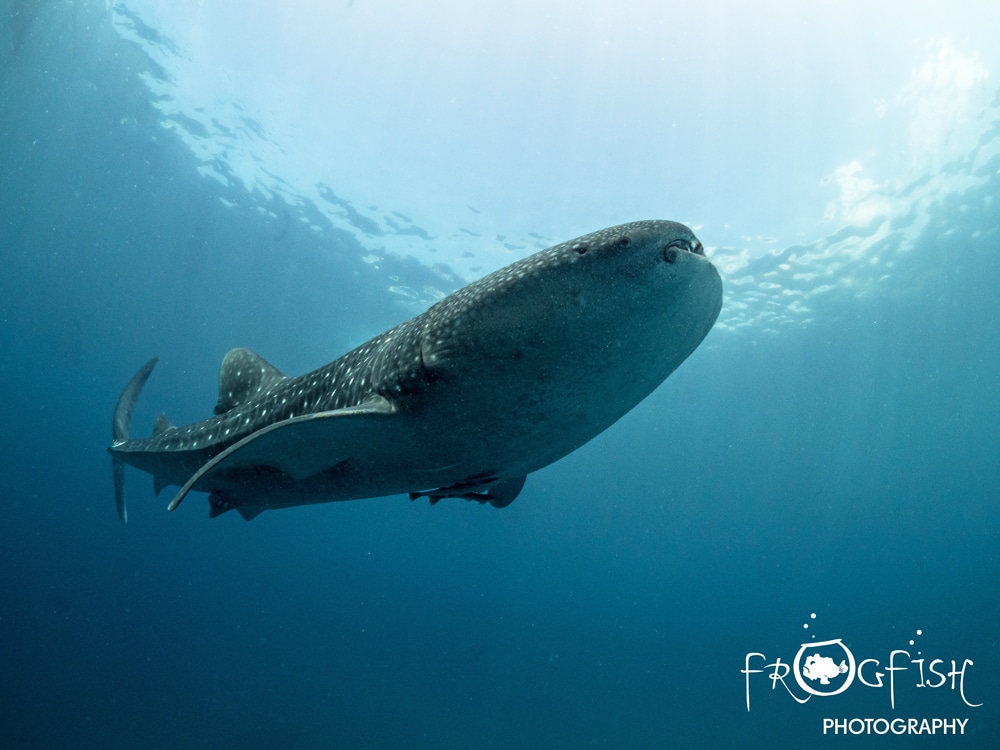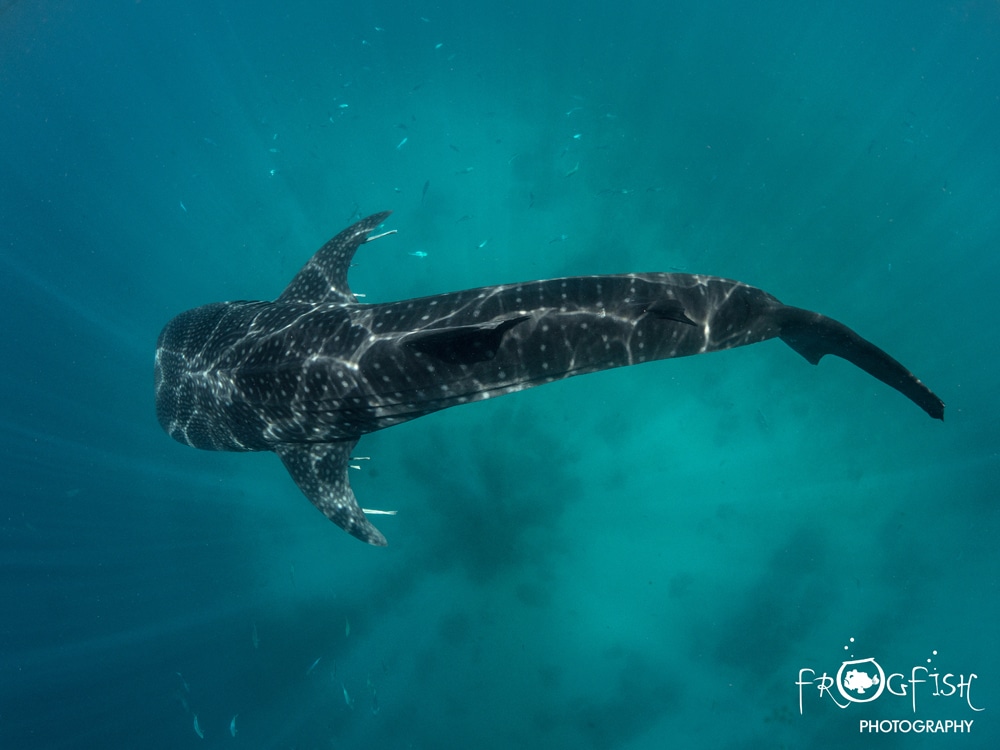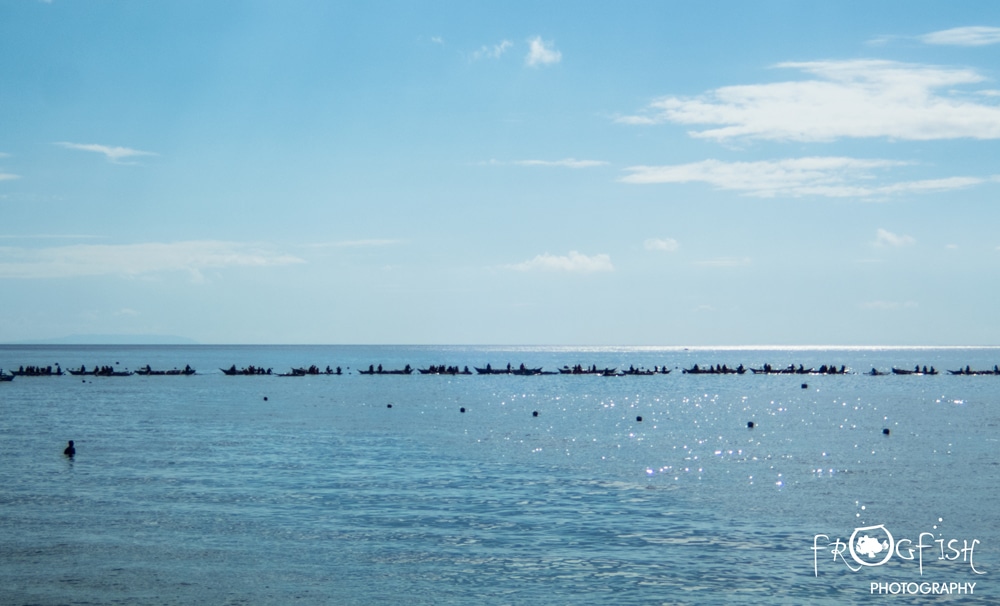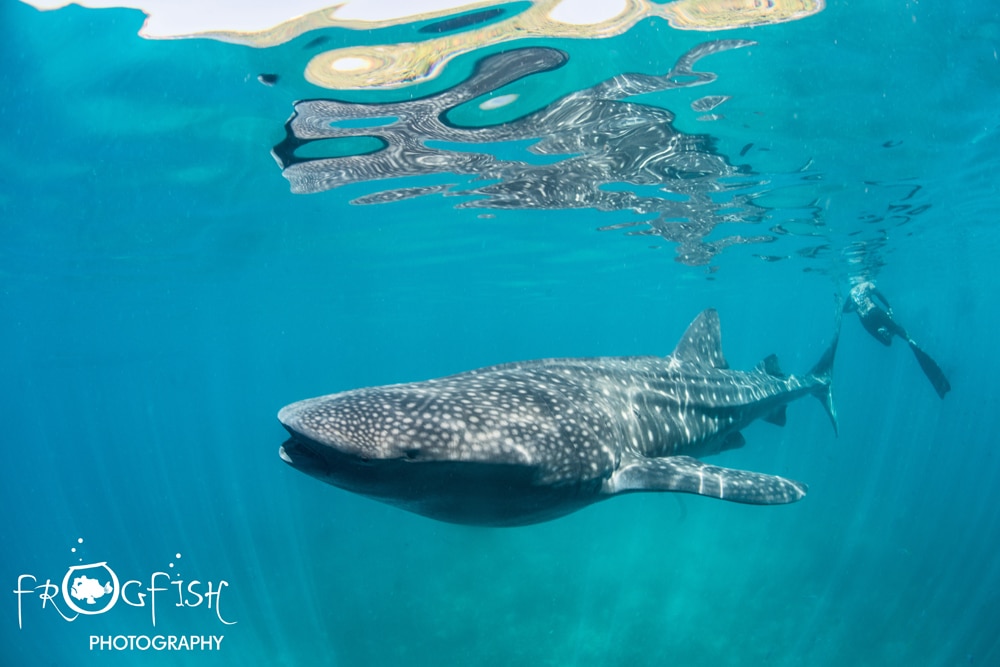News
The Whalesharks of Oslob
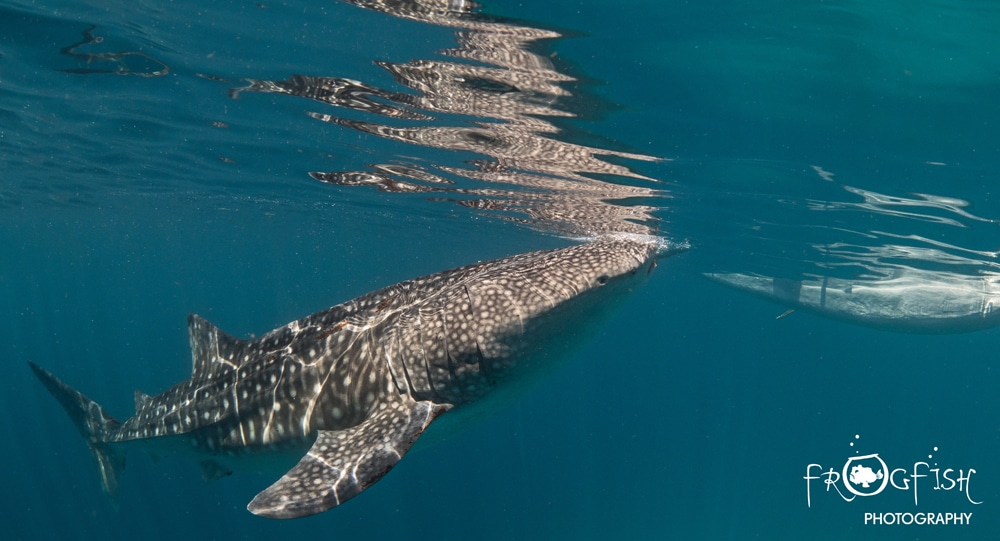
On our recent trip to the Philippines we were invited to visit the famous, but controversial, Whalesharks of Oslob. In the past, we had heard some negative reports about this experience and so it was with some trepidation that we agreed to go. First, we chatted to the team at Magic Island Dive Resort about what to expect. They told us that they used to boycott this experience themselves, as they had witnessed bad practices and only in the last few years, with tighter regulations being imposed, have they been taking their divers back to Oslob. With this expert local knowledge reassuring us, we packed up our camera gear and set off.
So, what goes on here? Well, for many years (some say over 100 years), way before it was a tourist attraction, fishermen have been feeding the Whalesharks that approach their boats, to keep them away from the nets and causing damage as they try to suck the tiny fish or shrimp through the small holes. In recent times, when people heard you could get up close with the magnificent fish, this practice started to bring in tourists. Now, the fishermen and the local village, make their livelihoods by selling tickets to see the Whalesharks. Tourists flock to Oslob in their thousands to get the chance to see and swim with the biggest fish in the sea.
We had arranged to do a dive first, as Magic Island Dive Resort is an accredited dive centre for this experience, and they are one of only a handful that are allowed to go beneath the surface. We geared up well outside the protected zone, as boats with engines are not allowed, so we shore-dived and swam towards the main attraction. Soon we were marvelling at the Whalesharks above us as they approached the boats to be fed. Our guide counted 12 Whalesharks, and they were mostly small to mid-sized juveniles. Sometimes the Whalesharks would dive deeper and come in to inspect us before returning to the surface. Our group of five divers and two guides were the only divers in the water, and we had an hour to spend underwater (one of the many rules of diving here). From below, you get a completely different view of this experience, and we were amazed at just how few people got into the water with the gentle giants.
To see what this experience is all about though, we also wanted to join one of the boats to snorkel with the Whalesharks, which is what the majority of people who come here do. At first glance, it looks too crowded and we were worried about what we might encounter. We got into our boat that was paddled out to the main feeding arena. You only get 30 minutes and so we were ready to get in as soon as our boat was in position. The number of boats out on the water, as well as the number of feeders, corresponds to the number of Whalesharks in the bay on that day. As there were 12 sharks, it seems that there were about 12 tourist boats too, so perhaps around 100 people every half an hour (from day break to lunchtime) going to see them.
We were very surprised to see that most people just watched from the boat, or got into the water, but held onto the boat, so there were only a handful of people in the open water. This made it a much more pleasurable experience than we were expecting. We were given very strict instructions on not approaching the sharks: we could not use strobes, we were not allowed to wear sun cream and we were told that getting too close would see us getting a red card and sent out of the water. We were delighted to see that, when one snorkeler broke these rules, he was sent out of the water immediately. The Whalesharks themselves were incredible, slowly approaching to be fed, sucking the tiny fish from the water just in front of us, sometimes horizontal, and sometime positioned vertically in the water to feed. It is amazing to see.
We had heard stories of Whalesharks that had terrible injuries from the boats hitting them, but the boats here do not use engines and the only injury we saw was the bottom of a tail missing, which is unlikely to have been a propeller injury. We had heard stories of tourists grabbing or even riding the sharks, but this was not our experience at all. We had heard that the sharks never leave, but they are free to come and go and most only stay a few days and then move on, with one individual out of the hundreds that have been recorded here staying for over 300 days, in a very rare case.
As with many shark-feeding programs, the worry is that we are changing the behaviour of these Whalesharks by the very act of feeding them. There is a research organisation called LAMAVE that are based in Oslob and their researchers are in the water every day. They have a database of Whaleshark IDs so that they can monitor which individuals are visiting the site and for how long.
Whalesharks are a migratory species that follow their food sources around the globe. LAMAVE have discovered that a handful of Whalesharks stay much longer than would be normal in this area and so their behaviour has changed. Most, though, stay for a short period of time and then move on. Of course, Whalesharks may also mistake other boats, not in this protected area, as potential food sources and therefore be more prone to propeller strikes in the future. We only did one snorkelling session and did not see any bad behaviour from the snorkellers, apart from one, who was swiftly dealt with, so we hope that this side of people’s concerns have been reduced.
The local economy is now not based on fishing as it once was, but instead is based on showing tens of thousands of people these magnificent fish. There is a new school, hospital and infrastructure in the region, funded by the tourists that come here. We were delighted to see a boat of local school children pull up next to ours, and to observe their excitement at seeing Whalesharks for the first time, in the wild, was wonderful. The more people that fall in love with our seas, oceans and marine life, the more likely it is that they will protect it. Here, the Whalesharks are worth more alive than dead with their fins cut off; it is a trade-off that we can live with.
There is so much more we could write about this, but it will have to wait for another time. We were expecting our experience with the Whalesharks of Oslob to be a negative one, based on the stories we had heard, but in fact we came away having enjoyed it and we were re-assured that it is not a circus. This is not for everyone, that is for sure. It is not a wild encounter. We hope that the work of LAMAVE will continue to improve how the experience is run, so that the impact on the majestic Whalesharks is kept to a minimum, giving divers, tourists and locals alike a chance to see one of nature’s gentle giants up close.
For more information please have a look at the following websites:
News
Book Review: Fire on Monroe Bravo by Fred Lockwood

Fire on Monroe Bravo is the latest book in the Jack Collier series by Fred Lockwood. Our story begins with our lead characters, Jack and Sandro, owners of Marine Salvage & Investigation Company, arriving on the Monroe Bravo Oil & Gas Platform in the North Sea. Having secured a contract for their vessel the MV Stavanger to act as support ship to the platform for TransGlobal Oil, our protagonists are on a celebratory visit.
However almost as soon as they arrive a series of explosions rock the platform, causing huge damage, loss of life and the very real danger of a massive human, ecological and financial disaster.

As the danger mounts for both our heroes and the surviving workers, Jack and Sandro will have to escape the inferno, all while trying to save the platform and the men still trapped unable to help themselves.
The disaster sets the scene for the unfolding story lines following the fate of the platform and our main characters, the police investigation into a suspected terrorist act and the actions of TransGlobal Oil as they attempt to navigate the pubic outcry and financial repercussions.
In his eighth book, Fire on Monroe Bravo, Fred Lockwood delivers an explosive thriller, with plenty of above and in-water drama, and our heroes fighting for survival, what more can you ask for?
We thoroughly recommend this read and look forward to the next in the series. For more information about his book series, you can check out the reviews of his previous books here on Scubaverse.
- Title: Fire On Monroe Bravo
- Author: Fred Lockwood
- ISBN: 979-8325324536
Available in a paperback version and for Kindle from Amazon and book stores.
Blogs
Alonissos: The complete diving destination (Part 1)

In June we were incredibly fortunate to be invited to dive in Alonissos, a small Greek Island in the Sporades island chain located in the North Aegean Sea. While I have long been a big fan of the Greek Islands as a great holiday destination, I had not had the opportunity to do any diving on previous visits and Mike and I were extremely excited to see what Alonissos had to offer both above and below the surface!

The Sporades are easily accessible via the airport in Skiathos (the first island in the chain), which is served by Jet2 flights from all major UK airports from May through October. Numerous ferries and charter boats make island hopping from Skiathos Town a breeze. After an hour boat ride, the picturesque port of Patitiri was a wonderful introduction to Alonissos, where we were met by our gracious hosts Kostas of Albedo Travel and Dias of Alonissos Triton Dive Center. Mike and I were delighted to be staying at the Paradise Hotel, aptly named for its stunning views over the sea and great location for walking to the waterfront.

Alonissos is beautifully situated in the National Marine Park of Alonissos and the Northern Sporades, the largest marine protected area in Europe. The surrounding seas offer fabulous marine life, including incredibly rare species such as the Mediterranean monk seal. They boast deep walls covered in gorgonians and sponges, stunning topography with caverns, swimthroughs and pinnacles, and the first accessible ancient shipwreck from 500BC!

In locations where historical sites have been reported, the waters are largely restricted, but with collaboration between government, underwater archeologists and dive centres, incredible underwater museums are being created for a truly unique diving experience. Alonissos is home to the first of these, the Ancient Shipwreck of Peristera Accessible Underwater Archeological Site. The chance to dive into history (along with reports of healthy reef life and amazing underwater topography) meant Mike and I were keen to get in the water.

Our introduction to the diving around Alonissos was at the Agios Georgios Pinnacles, in the channel between Alonissos and Skopelos. This fantastic site was named “The Chimney,’ and proved to have a huge amount to see. We got to a decent depth here (over 25m), and marvelled at a colourful reef wall with a wonderful swim through whose rocky walls were absolutely covered with life. As well as brilliant topography there was no shortage of macro life here. We saw numerous nudibranchs, five different species in total. The second dive at Mourtias reef nearby was a shallower dive along a nice wall with lots of crevices. Several moray eels and grouper called this site home. We enjoyed looking in the crevices for lobster and smaller benthic life, such as cup corals and tunicates.

Our itinerary allowed us two dives a day with afternoons left to explore the island with our hire car and evenings to enjoy the famous Greek hospitality. This proved to be a lovely mix of in-water and land based diversions.

The next days diving to the Gorgonian Gardens and Triton’s Cave was to be even better! These two stunning sites are nothing short of fabulous. The Gorgonian Gardens was a deep wall near to the Agios Georgios islands. The ever-present currents in this deep channel meant that the sea life was amazing … the namesake Gorgonian sea fans dotted the wall at a depth of 30 to 50 meters, getting ever larger the deeper we went. Above 30m was by no means less beautiful, with sponges, corals, scorpionfish, moray eels and some rare and colourful nudibranchs.

The second shallower dive of the day was to Triton’s Cave or the Cavern of Skopelos, on the east side of that island. The spectacular rock formations had wild striations both above and below the water making a truly epic topography. The cavern entrance was at 14m, and big enough for a buddy pair, winding up to 6m and passing two beautiful windows out into the blue. Emerging from the cavern, the light at the shallower depths and the incredible rock formations made for a fantastic gentle swimming safety stop and we all surfaced by the boat with massive grins.

Check out our next blog :Alonissos: The complete diving destination (Part 2)” to hear about our amazing dive on the 2500 year old Peristera Wreck!
Thanks to:
Alonissos Triton Dive Center https://bestdivingingreece.com/
Albedo Travel https://alonissosholidays.com/activities/
Paradise Hotel https://paradise-hotel.gr/
Alonissos Municipality https://alonissos.gr/en/
-

 Blogs2 months ago
Blogs2 months agoDiving With… Nico, Ocean Earth Travels, Indonesia
-

 News1 month ago
News1 month agoMurex Bangka Announce New Oceanfront Cottages & Beachfront Dining
-

 Blogs2 months ago
Blogs2 months agoA new idea in freediving from RAID
-

 Marine Life & Conservation1 month ago
Marine Life & Conservation1 month agoIceland issue millionaire whale hunter a licence to murder 128 vulnerable fin whales
-

 Marine Life & Conservation2 months ago
Marine Life & Conservation2 months agoThe Shark Trust Great Shark Snapshot is back
-

 News3 months ago
News3 months agoCharting New Waters; NovoScuba Goes Global with the Launch of their Revolutionary Dive Training Agency!
-

 Gear News1 month ago
Gear News1 month agoNew Suunto Ocean – a dive computer and GPS sports watch in one for adventures below and above the surface
-

 Marine Life & Conservation Blogs2 months ago
Marine Life & Conservation Blogs2 months agoBook Review: Plankton


